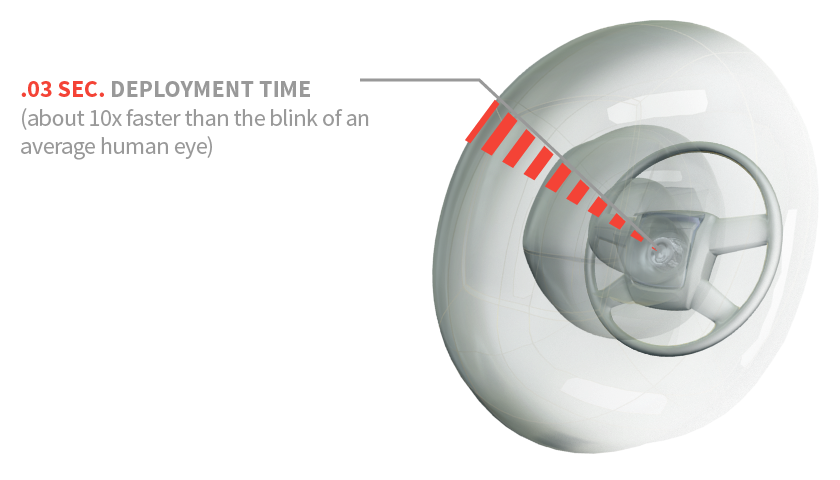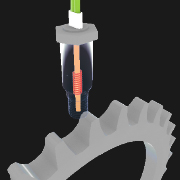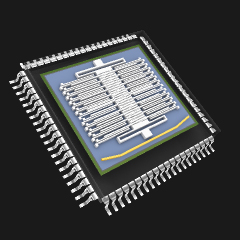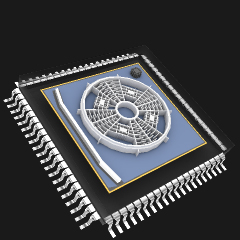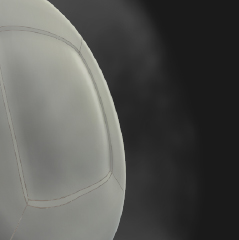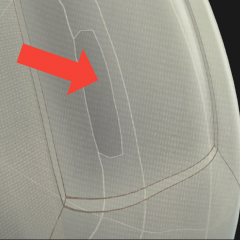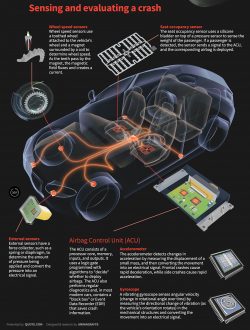How Airbags Work
Free Insurance Quote Comparison
Compare Quotes From Top Companies and Save
Secured with SHA-256 Encryption
Brad Larson
Licensed Insurance Agent
Brad Larson has been in the insurance industry for over 16 years. He specializes in helping clients navigate the claims process, with a particular emphasis on coverage analysis. He received his bachelor’s degree from the University of Utah in Political Science. He also holds an Associate in Claims (AIC) and Associate in General Insurance (AINS) designations, as well as a Utah Property and Casual...
Licensed Insurance Agent
UPDATED: Feb 12, 2025
It’s all about you. We want to help you make the right legal decisions.
We strive to help you make confident insurance and legal decisions. Finding trusted and reliable insurance quotes should be easy. This doesn’t influence our content. Our opinions are our own.
Editorial Guidelines: We are a free online resource for anyone interested in learning more about insurance. Our goal is to be an objective, third-party resource for everything legal and insurance related. We update our site regularly, and all content is reviewed by experts.
How Airbags Work
When a crash happens, sensors send data to a central “brain” (called the “Airbag Control Unit”). The ACU evaluates all incoming information to decide if air bag deployment is necessary, and if needed, deploy specific air bags.
The process usually happens in under 0.03 seconds, and before a human body would move toward it because of the crash.
Sensing and evaluating a crash
Wheel speed sensors
Wheel speed sensors use a toothed wheel attached to the vehicle’s wheel and a magnet surrounded by a coil to determine wheel speed. As the teeth pass by the magnet, the magnetic field fluxes and creates a current.
Seat occupancy sensor
The seat occupancy sensor uses a silicone bladder on top of a pressure sensor to sense the weight of the passenger. If a passenger is detected, the sensor sends a signal to the ACU, and the corresponding air bag is deployed.
External sensors
External sensors have a force collector, such as a spring or diaphragm, to determine the amount of pressure being applied and convert the pressure into an electrical signal.
Airbag Control Unit (ACU)
The ACU consists of a processor core, memory, inputs, and outputs. It uses a logic gate programmed with algorithms to “decide” whether to deploy air bags. The ACU also performs regular diagnostics and, in most modern cars, contains a “black box” or Event Data Recorder (EDR) that saves crash information.
Accelerometer
The accelerometer detects changes in acceleration by measuring the displacement of a small mass, and then converting the movement into an electrical signal. Frontal crashes cause rapid deceleration, while side crashes cause rapid acceleration.
Gyroscope
A vibrating gyroscope senses angular velocity (change in rotational angle over time) by measuring the directional change of vibration (as the vehicle’s orientation rotates) in the mechanical structures and converting the movement into an electrical signal.
Airbag inflation
The air bag inflation process must be immediate and precise.
Here are a couple of units that display common inflation techniques.
Pyrotechnical inflator
-
Propellant
The initiator heats a solid propellant that rapidly decomposes and produces nitrogen gas. The most common propellant chemicals used are phase-stabilized ammonium nitrate, and nitroguanidine.
-
Initiator
The initiator is an electric match, which is a bridgewire (an electrical conductor) wrapped in combustible material. Electrical currents heat up the bridgewire, which ignites the combustible material.
Heated gas inflator (HGI)
-
Diffuser
The heated gas exits the cylinder through the diffuser and into the air bag.
-
Second burst disk
The internal pressure increases enough to rupture the second burst disk.
-
Compressed gas cylinder
The compressed gas consists of hydrogen, oxygen, and nitrogen.
-
First burst disk
The initiator ruptures the first burst disk and heats the compressed gas.
-
Initiator
Similar to pyrotechnical inflators, the initiator in HGIs is also an electric match.
The air bag
Woven nylon fabric
Powder
The air bag assembly usually contains talcum powder or cornstarch as a lubricant so the air bag doesn’t get stuck on deployment.
Storage
Airbags are folded and stored in a compartment inside the vehicle, which has designated seams that tear open during deployment.
Vents
Airbags have vents in the back that allow them to slightly deflate and cushion the vehicle’s occupant as they make contact with it.
Airbag types
Side torso air bag
Side torso air bags have a lower, firmer chamber to support the pelvis and an upper, softer chamber to cushion the ribcage.
Side curtain air bag
Side curtain air bags stay inflated for several seconds to protect occupants if the vehicle rolls over.
Center air bag
Center air bags prevent impact between the driver and passenger or between the rear passengers.
Seatbelt air bags
Inflatable seatbelts increase the surface area against an occupant’s body to reduce injury.
Front air bags
Knee air bag
Knee air bags specifically prevent knees from shattering on impact.
References
- (2016). Safercar.gov. Retrieved 2 November 2016, from https://www.nhtsa.gov/campaign/safercargov?redirect-safercar-sitewide
- 2016 Accord Sedan Owner’s Guide. (2016) (1st ed., p. 12). Retrieved from http://techinfo.honda.com/rjanisis/pubs/QS/AH/AT2A1616OG4D/enu/AT2A1616OG-4D.pdf
- Airbag. (2016). En.wikipedia.org. Retrieved 2 November 2016, from https://en.wikipedia.org/wiki/Airbag
- Airbag Deploying in Slow Mo – The Slow Mo Guys. (2016). YouTube. Retrieved 2 November 2016, from https://www.youtube.com/watch?v=KRcajZHc6Yk
- Airbag Deployment Criteria. (2014) (1st ed., pp. 2-6). Retrieved from http://www.theforensicexaminer.com/2014/pdf/Air%20Bag%20Deployment.pdf
- Airbag Sensor. (2016) (1st ed.). Retrieved from http://www.g9toengineering.com/AllSaints/Airbag%20Sensor%20Model%202.0.pdf
- Airbags. (2016). Autoliv.com. Retrieved 2 November 2016, from https://www.autoliv.com/ProductsAndInnovations/PassiveSafetySystems/pages/air bags/default.aspx
- Clemson Vehicular Electronics Laboratory: Airbag Inflators. (2016). Cvel.clemson.edu. Retrieved 2 November 2016, from http://www.cvel.clemson.edu/auto/actuators/air bag.html
- COMPRESSED GAS INFLATOR WITH COMPOSITE OVERWRAP – Patent application. (2016). Patentsencyclopedia.com. Retrieved 2 November 2016, from https://www.patentsencyclopedia.com/app/20160084438
- EN | Bosch Angular-rate sensor SMG10x for rollover application. (2016). YouTube. Retrieved 2 November 2016, from https://www.youtube.com/watch?v=11MtJG2xrrc
- EN | Bosch Working principle of a pressure sensor. (2016). YouTube. Retrieved 2 November 2016, from https://www.youtube.com/watch?v=zXIeqeT_FC8
- Gyro sensors – How they work and what’s ahead | about Gyro sensor | Technical Information | other Information. (2016). Www5.epsondevice.com. Retrieved 2 November 2016, from https://www5.epsondevice.com/en/information/technical_info/gyro/
- How accelerometers work | Types of accelerometers. (2016). Explain that Stuff. Retrieved 2 November 2016, from https://www.explainthatstuff.com/accelerometers.html
- How air bag is made – material, production process, manufacture, history, used, processing, parts, components. (2016). Madehow.com. Retrieved 2 November 2016, from http://www.madehow.com/Volume-1/Air-Bag.html
- How it works – MEMS Accelerometer. (2016). YouTube. Retrieved 2 November 2016, from https://www.youtube.com/watch?v=ObXspXB9sJI
- Renaut, F. (2016). Studies on Mechatronics: MEMS Inertial Sensors Technology (1st ed., pp. 3-8). Zurich: Swiss Federal Institute of Technology. Retrieved from http://students.asl.ethz.ch/upl_pdf/383-report.pdf
- Midnight-cheeseater. research on air bag chemical reaction • /r/chemistry. (2016). reddit. Retrieved 3 November 2016, from https://www.reddit.com/r/chemistry/comments/5aqis5/research_on_air bag_chemical_reaction/
- Zanker, M. (2010). Real Gas Effects in Heated Gas Inflators (1st ed., pp. 1-8). University of Iowa. Retrieved from https://iro.uiowa.edu/esploro/
Share / embed code
• Copy/paste the code below to share this project on your site (in an iframe).
• We only require a link back to this page and name attribution (ex: “by Quote.com”)
Sharing images
(click for large versions)
